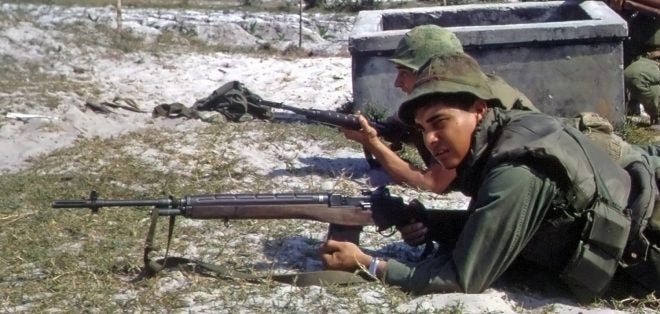According to a recent article on Soldier Systems, the US Army is considering an “interim” switch back to the 7.62mm caliber in standard infantry rifles. Eric Graves of the site lays out a reasonable overview of the situation on the ground, and what sort of weapons might be considered as the 7.62mm “interim” weapon. Follow the link to read his article over at soldiersystems.net.
I don’t usually editorialize on news articles like this, but I’d like to take a moment to list all the reasons switching back to an all-7.62mm fleet would be a very, very poor thing for the Army to do:
- Unit endurance would be cut in half. The infantry platoon would go from carrying 16,700 rounds of ammunition to carrying 9,400 rounds, a decrease of almost 44%. This means units would run out of ammunition in a little over half the time that they would with the current ammunition configuration.
- Soldier training would take much longer to reach similar proficiency levels, and more regular training would be necessary to maintain it. 7.62x51mm produces substantially more recoil than 5.56mm, even in heavier weapons, and it takes more skill to master weapons in this caliber. While this may not be a problem for the civilian deer hunter or recreational shooter, is a problem for a fighting force which must train thousands of recruits of different backgrounds and natural skill levels to proficiency, especially when the whole point of moving to 7.62mm would be to give more lethality at long range, where shots are even harder.
- Battlefield communication would suffer. One of the most significant observations that came from TFB’s recent live fire exercise with WWII-era weaponry, conducted by Miles V, was that .30 caliber weapons produce a much larger volume of noise per shot, which greatly increases the difficulty of hearing commands given by officers and squad leaders.
- US Army units would lose their fire superiority at short range. One of the major infantry combat lessons of World War II, Korea, and Vietnam was that he who shoots the most tends to win, or at least makes it very, very hard on the other guy. The larger 7.62mm caliber brings with it a serious disadvantage in this area, which is why it and other similar calibers have been virtually universally dropped as standard rifle rounds in military forces all over the world.
In short, a switch to the 7.62mm NATO amounts to trading one relatively minor problem – that of confronting medium machine guns with small units like the fireteam or squad – for a major one. The reality of achieving fire superiority at short range with lightweight ammunition from rapid fire guns is one that is so important that it shaped the landscape of 20th Century small arms design ever since the end of World War II.
The problem with this even as an “interim” solution is that so many “interim” systems went on to become permanent ones. Before .30 cal fans object to this point, they might consider that the US Army’s longest serving rifle, the M16/M4 family, was originally adopted as an “interim” design before the ambitious SPIW program bore fruit… Which it never did.
It’s a simple reality that the range disadvantage that current 5.56mm shoulder arms have versus tripod-mounted 7.62mm machine guns is not one that will lose the US Army any battles – let alone wars – anytime soon. A change in armaments can certainly wait until something better comes along.
 Your Privacy Choices
Your Privacy Choices
